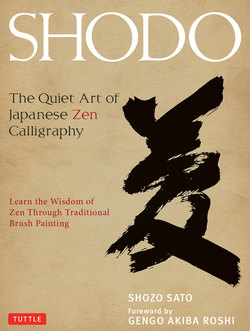Читать книгу Shodo - Shozo Sato - Страница 10
На сайте Литреса книга снята с продажи.
ОглавлениеCHAPTER 2
THE FOUR
TREASURES IN
SHODO
Chinese ideograms were brought to Japan during the sixth century along with Buddhism. However, in those early days, reading and writing were limited to royalty and selected members of the court. During the centuries that followed there were countless power struggles among the warlords. However, by the beginning of the Edo period (1615–1868 CE) with the rise of the Tokugawa Bakufu, Ieyasu recognized the many advantages of promoting aspects of Chinese culture, predominantly the philosophies of Confucianism (551–479 BCE) and Taoism (Lao Tzu, 604–531 BCE). The Bakufu (another name for the Tokugawas) employed teachers of Confucius to promote beliefs through reading, writing and even memorizing passages from the Analects of Confucius.
Zen buddhism, which had been brought to Japan from China during the Kamakura Period (1185–1333 CD), incorporated the philosophies of both Confucianism and Taoism and was very compatible with the sensibilities and approach to life among the warrior classes. The warriors and rich merchants who were retired gave rise to a class of the populace called the "literati" or bunjin (bun=literature; jin=person). This class was well versed in reading and writing, and the bunjin were especially involved with creating paintings which were accompanied by either Chinese or Japanese poetry.
They cultivated the arts of calligraphy, painting, and the Chinese style of drinking brewed green tea (added to the existing tea ceremony), all of which became important pastimes. The “four treasures” from the ancient Chinese—the brush, sumi ink, the grinding stone and paper—became revered items. An interesting object used in both shodo and painting, the suiteki, a miniaturized container to hold water, was no doubt inspired by the tea pot used in brewing green tea.
BRUSHES
Fude
